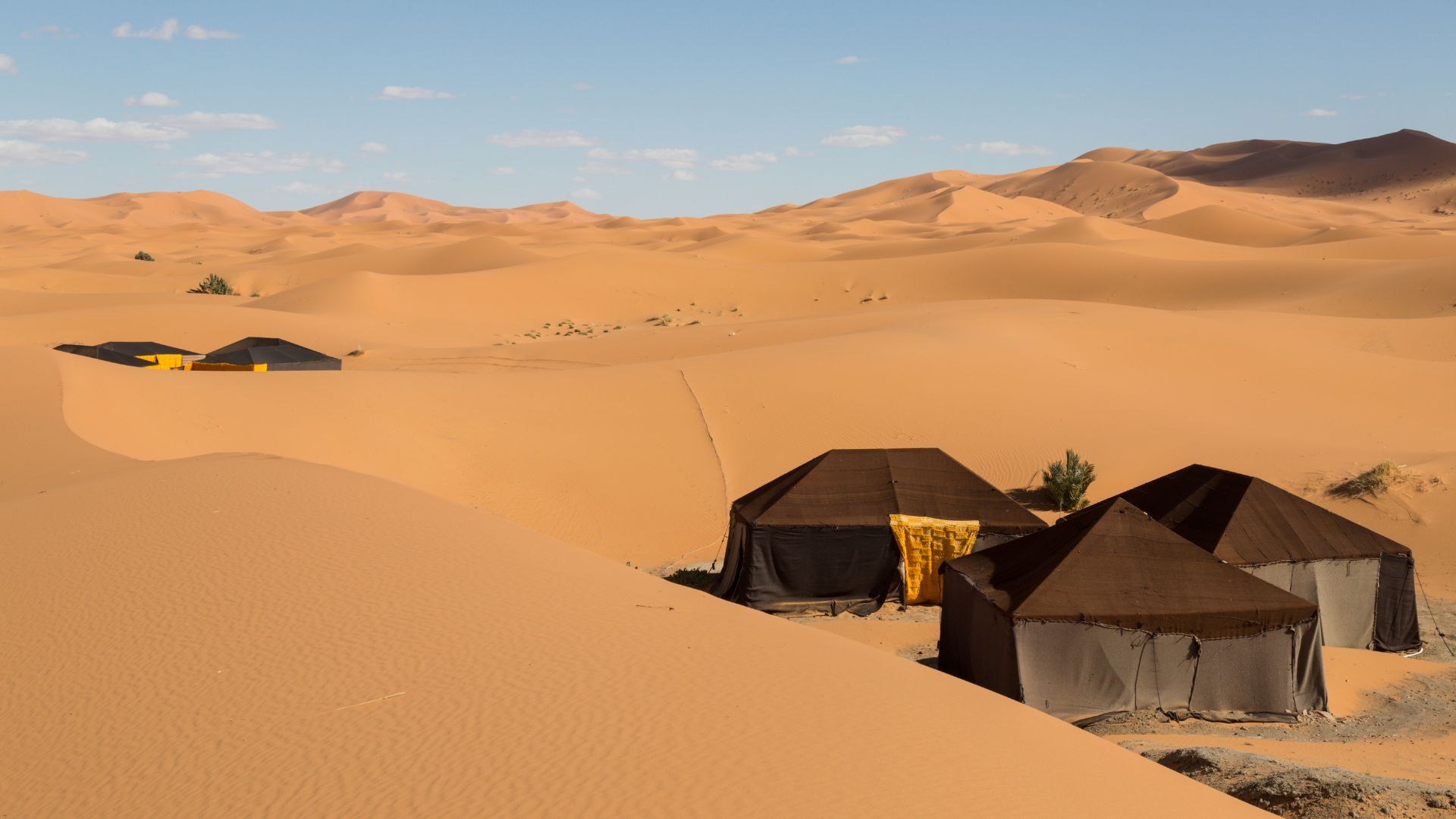Desert environments have their charm. But if you are going to spend a lot of time in a hot desert, the extreme temperatures, limited water sources, and scarce vegetation may lead to uncomfortable situations. One way to somewhat insulate yourself from high temperatures and sandy wind is by building a shelter. In a desert, shelters can be constructed from rocks, sandbags, branches, or tarps. Here’s how to do it.
Find a good location
When choosing a spot for your shelter, seek out natural features that can offer shade and protection. Rock formations, dunes, and cliffs are options to consider, as they provide natural barriers against the sun and wind. Overhangs and hollows in rock formations can serve as pre-existing shelters that require minimal modification.
Also consider wind direction to minimize the intrusion of sand and to enhance ventilation. Position your shelter so that the entrance is away from the wind, reducing the amount of sand that can blow inside. Proper orientation will also help maintain a cooler temperature inside the shelter.
Note that while low-lying areas may seem like convenient spots, they can become hazardous during rare but intense desert rainstorms. These areas are prone to flash flooding, which can quickly inundate your shelter. Choose elevated ground with good natural drainage to avoid water accumulation.
If you’re running low on water or suspect it might happen later, build the shelter near a water source. Look for signs of vegetation, which can indicate underground water, and observe wildlife behavior, as animals often know the best places to find water.
Last but not least, ensure that your chosen location is free from falling rocks, venomous animals, or sharp objects. Clear the area of debris that could cause injuries or make your shelter uncomfortable. It’s also wise to inspect for signs of animal activity to avoid unwelcome encounters.
Use natural and synthetic materials
Both the desert and your backpack can provide useful building materials. For instance, rocks can be used to build the foundation and walls of your shelter, providing stability and protection against wind and sand. Sand can be piled to form walls or to help insulate a trench shelter. Branches and sticks can be used to construct the frame of your shelter, creating a stable structure. Easy, right?
If you have access to portable materials, these can greatly enhance the effectiveness of your shelter. A tarp is versatile and can be used to cover your shelter, providing protection from the sun, wind, and rain. In the absence of a tarp, blankets, and ponchos can be layered to offer some degree of protection. Paracord or rope is essential for securing branches, tarps, or other materials together, creating a stable shelter.
And since we were speaking of portable materials, feel free to check our guide on what to wear in a hot desert.
Build the shelter in 4 steps
Constructing a great desert shelter can be largely about the efficient use of available materials. Here are four steps you might want to follow.
Step 1: Construct the frame
An A-frame structure can be an effective and straightforward structure for your desert home. Select sturdy branches or poles, leaning them against each other to form an “A” shape, and securing the top with rope, paracord, or natural materials like vines. Alternatively, you can build a dome-shaped structure using flexible branches bent into a semicircular shape, which is particularly effective at withstanding wind.
Step 2: Stabilize the structure
Place large rocks at the base of your frame to anchor it securely to the ground. This may prevent the shelter from being blown away by desert winds. For additional stability, drive stakes into the ground around the base of the frame and tie the structure to these stakes.
Step 3: Cover the frame
Use branches, leaves, grass, or any available vegetation to cover the frame, providing insulation and some degree of protection from the outside. If you have a tarp, blanket, or large piece of fabric, drape it over the frame and secure it with rocks or by tying it down.
Step 4: Insulate and ventilate
Add layers of natural materials like grass or leaves inside the shelter to create a comfortable and insulated floor, retaining heat during cold desert nights. Ensure there is adequate ventilation to prevent overheating. Create small openings at the top or sides of the shelter to allow air to circulate.
Special techniques for trench shelters
A trench shelter involves digging a trench about 45 to 60 cm (17 to 23 in) deep and long enough to lie in comfortably. Pile the excavated sand around the trench to form walls. Cover the trench with a tarp or fabric, securing it with rocks or other weights. Creating a double-layer cover with an air gap between the two layers of material can further reduce the inside temperature by enhancing insulation.
Step 5: Secure the shelter
Use reflective materials like emergency blankets or aluminum foil on the exterior of your shelter to deflect sunlight, reducing heat absorption. Position your shelter to maximize natural shade throughout the day, using natural features like cliffs, large rocks, or trees.
Secure your shelter firmly to the ground using ropes, cords, or stakes. Add extra weight with rocks or sandbags to enhance stability. Construct your shelter with the entrance facing away from the prevailing wind direction to minimize sand and dust ingress.
Prevent sand infiltration by sealing any gaps or openings with breathable fabric or mesh screens. Building low walls around the shelter using rocks or sandbags can block wind-blown sand from entering.
While deserts don’t have much rain, you need to prepare yourself for all situations. Ensure your shelter covering is waterproof or treated with a water-repellent substance. Construct your shelter in a location with natural drainage to prevent water accumulation. Digging small trenches around your shelter can help divert water away and keep the interior dry.
Assuming that, for some reason, you’re going to use the shelter for a long period of time, regularly inspect your shelter for any signs of wear and tear, particularly the frame and any areas where materials are joined together. Address any damage as soon as you notice it, using available materials like rope, cord, or natural fibers to reinforce and repair these areas. Ensure that all anchor points are secure and add extra weight if needed to combat high winds. Add extra branches or poles to the frame as needed to maintain stability.
Reapply waterproofing sprays or sealants to tarps and fabrics to ensure they remain effective at keeping out moisture. Regularly refresh the insulating materials inside your shelter to improve heat retention and overall comfort.
Embrace your inner desert dweller
You’re now closer to becoming a true desert survivalist, ready to take on some harsh conditions a hot desert can throw at you. Or at least you’re on the right path. To learn more, check out our guide on how to survive in a hot desert and our list of survival skills for trekkers.
So, the next time you find yourself stranded in the middle of nowhere with nothing but your wits and a piece of paracord, remember these tips and transform into the ultimate desert-dwelling guru. And if all else fails, just think of it as an extreme camping adventure.









